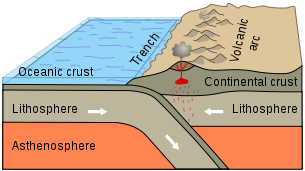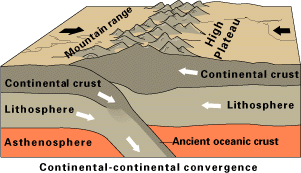Formation of an orogen is accomplished in part by the tectonic processes of subduction, where a continent rides forcefully over an oceanic plate (noncollisional orogens), or
 |
| Above:
Subduction of an
oceanic plate
by a
continental plate to form a noncollisional orogen. Below: Continental collision of two continental plates to form a collisional orogen. |
 |
Orogeny usually produces long arcuate (from arcuare, to bend like a bow) structures, known as orogenic belts. Generally, orogenic belts consist of long parallel strips of rock exhibiting similar characteristics along the length of the belt. Orogenic belts are associated with subduction zones, which consume crust, produce volcanoes, and build island arcs. The arcuate structure is attributed to the rigidity of the descending plate, and island arc cusps are related to tears in the descending lithosphere. These island arcs may be added to a continent during an orogenic event.
The processes of orogeny can take tens of millions of years and build mountains from plains or even the ocean floor. The topographic height of orogenic mountains is related to the principle of isostasy, that is, a balance of the downward gravitational force upon an upthrust mountain range (composed of light, continental crust material) and the buoyant upward forces exerted by the dense underlying mantle.
Frequently, rock formations that undergo orogeny are severely deformed and undergo metamorphism. During orogeny, deeply buried rocks may be pushed to the surface. Sea bottom and near shore material may cover some or all of the orogenic area. If the orogeny is due to two continents colliding, the resulting mountains can be very high (see Himalaya).
An orogenic event may be studied as (a) a tectonic structural event, (b) as a geographical event, and (c) a chronological event. Orogenic events (a) cause distinctive structural phenomena related to tectonic activity, (b) affect rocks and crust in particular regions, and (c) happen within a specific period of time.
Orogenic cycle
Although orogeny involves plate tectonics, the tectonic forces result in a variety of associated phenomena, including magmatization, metamorphism, crustal melting, and crustal thickening. Just what happens in a specific orogen depends upon the strength and rheology of the continental lithosphere, and how these properties change during orogenesis.
In addition to orogeny, the orogen once formed is subject to other processes, such as sedimentation and erosion. The sequence of repeated cycles of sedimentation, deposition and erosion, followed by burial and metamorphism, and then by formation of granitic batholiths and tectonic uplift to form mountain chains, is called the orogenic cycle. For example, the Caledonian Orogeny refers to the Silurian and Devonian events that resulted from the collision of Laurentia with Eastern Avalonia and other former fragments of Gondwana. The Caledonian Orogen resulted from these events and various others that are part of its peculiar orogenic cycle.
In simple summary, an orogeny is a long-lived deformational episode in which many geological phenomena play a role. The orogeny of an orogen is only part of the orogen's orogenic cycle. Among the other phases is erosion, described next.
Erosion
Erosion inevitably removes much of the mountains, exposing the core or mountain roots (metamorphic rocks brought to the surface from a depth of several kilometers). Such exhumation may be helped by isostatic movements balancing out the buoyancy of the evolving orogen. There is debate about the extent to which erosion modifies the patterns of tectonic deformation (see erosion and tectonics). Thus, the final form of the majority of old orogenic belts is a long arcuate strip of crystalline metamorphic rocks sequentially below younger sediments which are thrust atop them and dip away from the orogenic core.
An orogen may be almost completely eroded away, and only recognizable by studying (old) rocks that bear traces of orogenesis. Orogens are usually long, thin, arcuate tracts of rock that have a pronounced linear structure resulting in terranes or blocks of deformed rocks, separated generally by suture zones or dipping thrust faults. These thrust faults carry relatively thin slices of rock (which are called nappes or thrust sheets, and differ from tectonic plates) from the core of the shortening orogen out toward the margins, and are intimately associated with folds and the development of metamorphism.
Biology
The study of orogeny, coupled with biogeography (the study of the distribution and evolution of flora and fauna), geography and mid ocean ridges in the 1950s and 1960s, contributed greatly to the theory of plate tectonics. Even at a very early stage, life played a significant role in the continued existence of oceans, by affecting the composition of the atmosphere. The existence of oceans is critical to sea-floor spreading and subduction.
Relationship to mountain building
Mountain formation occurs through a number of mechanisms:
“Mountain complexes result from irregular successions of tectonic responses due to sea-floor spreading, shifting lithosphere plates, transform faults, and colliding, coupled and uncoupled continental margins.” (Peter J Coney (1970). "The Geotectonic Cycle and the New Global Tectonics". Geological Society of America Bulletin 81 (3): 739-748)
Large modern orogenies often lie on the margins of continents; the Alleghenian (Appalachian), Laramide, and Andean orogenies are examples of these in the Americas. Older, now inactive orogenies, such as the Penokean and Antler, are represented by deformed rocks and sedimentary basins further inland.
Areas that are rifting apart, such as the mid-ocean ridges and the East African Rift have mountains due to thermal buoyancy related to the hot mantle underneath them; this thermal buoyancy is known as dynamic topography. In strike-slip systems, such as the San Andreas Fault, restraining bends result in regions of localized crustal shortening and mountain building without a plate-margin-wide orogeny. Hotspot volcanism results in the formation of isolated mountains and mountain chains that are not necessarily on tectonic plate boundaries.
Regions can also experience uplift as a result of
delamination of the lithosphere,
in which an unstable portion of cold
lithospheric root drips down into the
mantle, decreasing the density of the lithosphere and causing buoyant
uplift. An example is the
Sierra Nevada in
California. This
range of
fault-block mountains
experienced renewed uplift after a delamination of the lithosphere beneath
them.
Finally, uplift and erosion related to
epeirogenesis
(large-scale vertical motions of portions of continents without much
associated folding, metamorphism, or deformation) can create local
topographic highs.
End of Reading
Return to the Old Earth Ministries Online Earth History Curriculum homepage.
![]()
Source: Orogeny